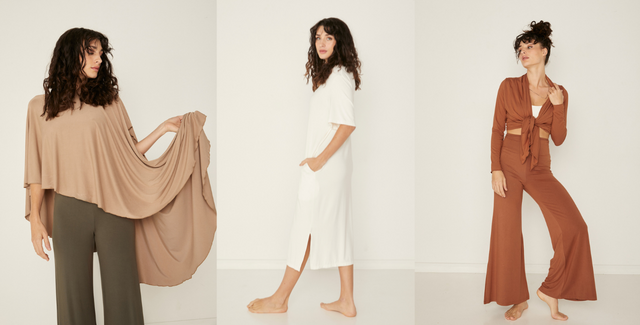Fashion trends come and go, but some breakthroughs leave a lasting impact. Bamboo apparel is one of them. From everyday basics to activewear and loungewear, Bamboo fabric is quickly becoming a go-to option for those looking for something stylish and reliable. But what is driving this shift?
In this blog, we'll explore key questions such as "What is Bamboo clothing?" and "How is Bamboo clothing made?" We'll also explore what the benefits of Bamboo clothing are and discuss consumer preferences to better examine its growing popularity.
Understanding Bamboo clothing and how it is made
To know why Bamboo clothing is becoming more recognised, we’ll start with the basics. Simply put, Bamboo clothing is apparel made from the Bamboo plant. Bamboo stalks are harvested at maturity and then processed (either mechanically or chemically) to obtain the fibres that will later be spun into fabric.
These fibres can be used alone or blended with other materials such as organic cotton, linen or elastane. Some blends improve stretch and durability, while others enhance breathability or add structure to garments. The final fabric varies in texture and weight, making Bamboo a versatile option for different clothing styles.
Growing demand for eco-friendly fashion
One of the key drivers behind Bamboo clothing’s rise in popularity is the surging demand for sustainable fashion. Consumers today are more aware of the environmental impact of their clothing choices, and many are searching for alternatives to conventional fabrics.
Unlike cotton, which requires large amounts of water and pesticides to cultivate, Bamboo is a self-sustaining crop that grows quickly with minimal resources. It regenerates naturally, requires no replanting and can thrive without chemical treatments, making it a more sustainable option for textile production.
Additionally, the production process of Bamboo fabric has seen advancements in recent years, reducing its overall environmental footprint. Many manufacturers now use closed-loop systems, where chemicals used in the processing stage are captured and reused instead of being released into the environment.
Natural benefits of Bamboo apparel that appeal to consumers
Beyond being sustainable, Bamboo clothing is packed with unique properties that benefit the wearer and add to its growing appeal:
- Breathability and temperature regulation
Bamboo fabric has high air permeability — it allows air to flow freely through the fibres. This natural breathability can help regulate body temperature by keeping heat from getting trapped, making Bamboo clothing ideal for warm climates. At the same time, the fabric provides insulation when temperatures drop, offering a balance between staying cool in the summer and retaining warmth in cooler seasons.
- Moisture-wicking and odour-resistance
Bamboo fibres naturally draw moisture away from the skin, preventing dampness and helping to keep the fabric dry. This makes Bamboo clothing especially useful for activewear and undergarments, where breathability and dryness are essential. By helping sweat evaporate quickly, Bamboo clothing also reduces the likelihood of odour buildup, keeping garments fresher for longer.
- Hypoallergenic and gentle on the skin
Bamboo fabric is naturally hypoallergenic, as it contains fewer irritants that may trigger skin reactions. It has a smooth texture with no rough fibres, making it a gentler option for those prone to skin sensitivities, allergies or irritation caused by synthetic fabrics. This makes Bamboo a preferred choice for people with conditions such as eczema or those who simply prefer soft, skin-friendly clothing.
- Remarkable longevity
While lightweight, Bamboo fibres are known to hold their shape well, meaning garments are less likely to sag or lose structure over time. With proper care, Bamboo clothing can retain its original fit and texture even after multiple washes. This makes it a practical choice for those looking for clothing that lasts, reducing the need for frequent replacements.
A shift in consumer preferences
The shift towards Bamboo clothing isn’t just about sustainability — it’s also about changing preferences in fashion. More shoppers now prioritise comfort, function and durability when choosing their wardrobe staples. Bamboo fabric’s natural ability to adapt to different conditions makes it an appealing choice for modern consumers looking for clothing that fits seamlessly into their lifestyle.
Another factor driving interest is the increase in availability. More brands are introducing Bamboo-based collections, making it easier for consumers to find and purchase these products. Whether it’s casual wear, sleepwear or even workwear, Bamboo clothing is becoming more accessible across different categories.
Where to buy Bamboo clothing and what to look for when shopping
As Bamboo clothing continues to gain popularity, it's important to know that not all Bamboo apparel is made the same. Here are key factors to look for in a brand when shopping for Bamboo clothing:
- Premium fabric composition
Opt for brands that use high-quality Bamboo blends, ideally with at least 92% Bamboo content, to retain the fabric’s natural benefits and provide optimum softness. Responsible processing methods also contribute to a high-quality finish that holds up well over time.
- Ethical and sustainable sourcing
Transparency matters. Look for companies that work with sustainable suppliers and ethical production facilities, ensuring fair labour practices and environmentally mindful manufacturing.
- Style without sacrifice
Sustainability shouldn’t mean compromising on style. The best Bamboo clothing brands offer modern, well-crafted designs that blend fashion with function, allowing you to build a wardrobe that’s both stylish and eco-conscious.
Discover the best of Bamboo clothing with Bodypeace Bamboo Clothing
At Bodypeace Bamboo, we take pride in offering premium Bamboo apparel that meets the needs and preferences of modern consumers.
Our garments are crafted with a 92% Bamboo and 8% elastane blend, ensuring the natural benefits of breathability, moisture control and a luxuriously soft feel against the skin. The elastane ensures the garments stretch comfortably with your body whilst also keeping the shape. We prioritise ethical and sustainable practices, working with responsible production facilities to create clothing that aligns with mindful fashion choices.
From refined basics and incredibly comfy underwear to statement pieces, our collection showcases the best of what Bamboo clothing has to offer. Explore our range of men’s and women’s styles today and discover why more people are choosing this wonder fibre as a staple in their wardrobe.









